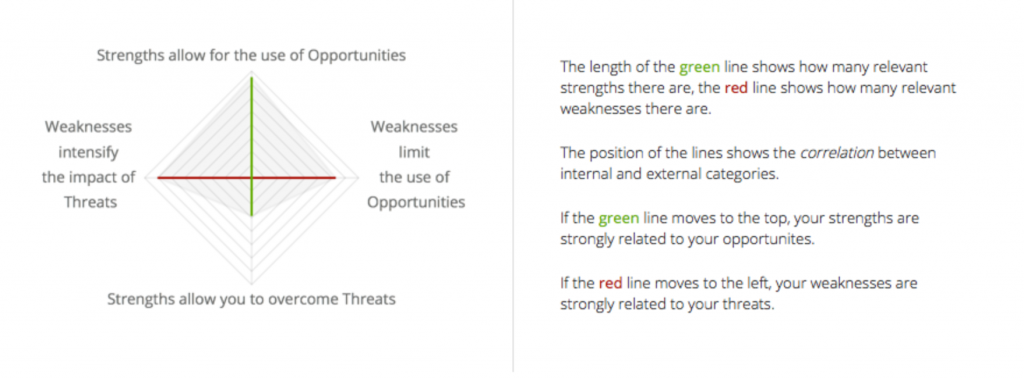Today’s article focuses on the final outcome of the SWOT analysis process: strategy. Let’s take a look at the whole process once again: 
What is strategy?
Quoting the definition from Wikipedia:
Strategy (from Greek στρατηγία stratēgia, “art of troop leader; office of general, command, generalship”) is a high level plan to achieve one or more goals under conditions of uncertainty. Strategy is important because the resources available to achieve these goals are usually limited.
Take a look at an analogy from real life. Let’s imagine that we want to go on vacation by car. First we need to choose our travel destination and take under consideration our resources (how many days of holidays do we have, how much money do we have, etc…). When we choose a destination, we need to define the route (select places for pit stops, check fuel cost, cost of tollroads, etc…). This route must be carefully selected, because we have a predefined amount of fuel and limited time to get to the place we chose.
How to build strategy?
After defining the entire plan, we might need to optimize the route or even change the destination, and finally decide where we will go and start to prepare the journey. The actions we engage in before hitting the road we might call: “building the strategy”. If we prepare well by taking under consideration many factors and planning in advance, the probability of having pleasant and even unforgettable holidays will be higher. It does not mean that anything unexpected will not happen. We might need to change the plan during our journey, but we will be prepared better for this change, and if everything goes right we can achieve the desired goal.
The same pattern applies to business. When we talk about strategy, we think about checking different possibilities and choosing the best fit for current and future situations. That is why SWOT is a excellent method to support the building of strategy. First, we describe the current and future situations (Analysis step), then we select the most important factors (Selection step), next we evaluate how important they are (Evaluation step) and finally we check to see, if they influence each other (Connection step). As a result of all the above steps we receive our final strategy.
How can one develop strategy?
Depending on the relationships between the features we have defined, the outcome of the strategy can be different. Our internal features such as strengths or weaknesses can interact in different ways with external factors - opportunities or threats. For instance, one strength can either: interfere strongly with our opportunity (more literally: the strength allows to use the opportunity) or interfere strongly with our threat (more literally: the strength allows to overcome the threat).
Defining this kind of relationships allows to build a 4-dimensional grid, where each dimension represents the impact of a given type of relationships, and - consequently - shows which business strategy is the most relevant. The definition of final strategy can be viewed as a the result of a tug of war between different aspects of our business. The main difference between choosing a strategy and a regular tug of war is that in strategic planning, not always only one side wins. The image below shows a chart which we use in CayenneApps SWOT to visualize a business strategy grid.

Each axis represents interactions between strengths and weaknesses among external factors. The vertical axis describes how strengths interact between opportunities and threats, and the horizontal axis does the same for weaknesses.
Each line represents the intensity of interactions. The longer the line is, the more interactions exist. Each corner of rhombus represents each side of a strategic tug of war. In fact, relations like: strengths empower opportunities can be easily translated into the more general term of 4 major business strategies.
Four major business strategies.
What does this translation look like? Let’s take a look at a short overview of these major strategies.
Strengths allow for the use of opportunities translates as Aggressive Strategy.
Explanation: You have a lot of strengths, and more importantly these strengths are strongly connected with opportunities that exist in the external environment. This is the best possible scenario in which to execute your plans. Focus on utilising opportunities which are waiting for you and make use of your internal strengths. Use your internal strengths comprehensively to gain an advantage.
Strengths allow threats to be overcome translates as Diversification Strategy.
Explanation: You have an unfriendly external environment (which results in a lot of threats), but your strengths are very solid. Unfortunately, your strengths don’t correspond with your opportunities, which the external environment is providing you (your company or your project), so you are not able to properly utilise these opportunities. Use your strengths and explore new opportunities. Build competitive advantages or find an attractive niche.
Weaknesses limit opportunities translates as Turnaround Strategy.
Explanation: You have a friendly external environment with a lot of opportunities, but you also have severe weaknesses which don’t allow you to fully utilise your opportunities. You may be in a new emerging market, but don’t have the resources to fully make use of your position. Try to reduce your weaknesses, which are blocking you from using opportunities. Focus on your biggest opportunities and do everything in your power to exploit them.
Weaknesses intensify threats translates as Defensive Strategy.
Explanation: You weaknesses are predominant, and are strongly intensified by surrounding threats. Be warned: there is a possibility that without any changes your company or project will fail! Survival should be your main goal now. Avoid threats and try to eliminate weaknesses with the biggest impact. Focus on internal problems and try to eliminate them, but do not seek new opportunities now.
Summary
Developing strategy can be described as defining long-term plans which are aligned with our current goals amid some level of uncertainty.
To do so, we need to analyze our situation, focus on internal features, external factors and the relationship between them. The strength of the connection between the pairs of internal-external features can be effectively used to determine your final strategy.
There are 4 major business strategies: aggressive, diversification, turnaround and defensive. Each of them suggest actions which need to be taken in different situations, which may exist in the business environment. Knowing your optimum strategy can help you to focus on things that really matter and execute or even change your plan more effectively.

[…] STRATEGY: At the end of the process you will receive full summary of pertinent data, as well as a recommended strategy for your current situation and suggestions for future actions (read more). […]
[…] button and waited for the final verdict. In the blink of an eye, the result appeared on the screen: “Aggressive strategy”. Then we […]